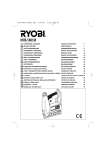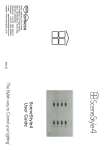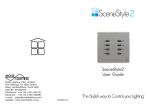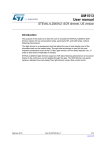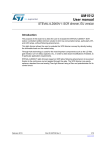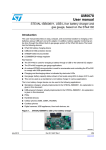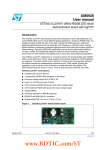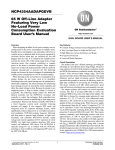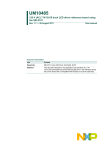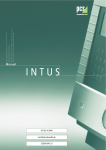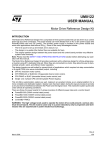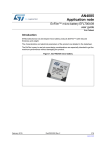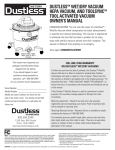Download STEVAL-ILD004V1: leading-edge dimmer
Transcript
UM1597 User manual STEVAL-ILD004V1: leading-edge dimmer Introduction The purpose of this board is to propose an innovative and low cost power topology using two sensitive SCRs and a single IGBT to dim all kind of lamps: 100 - 240 V halogen lamps, SELV halogen lamps through magnetic or electronic transformers, and the new CFL and LED dimmable lamps. The main features of this dimmer are: • Operation for 2-wire wall dimmer • Leading-edge control only (compatible with all lamps commonly found on the shelves) • Operation on 110 V or 230 V line rms voltage and 50 Hz or 60 Hz line frequency • Dimmable power range (note: higher power is possible with larger heatsink): – 3 to 600 W for 230 V rms line – 3 to 300 W for 110 V rms line – power efficiency @ 230 V > 99% – standby losses @ 230 V < 0.3 W • Short-circuit protection at startup • Enhanced interface with pushbuttons; soft-start and soft-stop; memory of last setting • Compliance with EMC standards: – Compliant with EN55015 (for European market) – Criteria A for 2 kV IEC 61000-4-5 surge for fast transients above 2.5 kV according to IEC 61000-4-4) This document describes the principle and operating conditions of this demonstration board. The performance of this board is described regarding power losses and EMC standard test results. The description of the user interface and connections will help users to setup and evaluate this dimmer. Figure 1. STEVAL-ILD004V1 board November 2014 DocID024045 Rev 3 1/27 www.st.com Contents UM1597 Contents Contents. . . . . . . . . . . . . . . . . . . . . . . . . . . . . . . . . . . . . . . . . . . . . . . . . . . . . . . . . . . . 2 1 Operation principle and targeted application . . . . . . . . . . . . . . . . . . . . . 4 1.1 Dimmer for CFL, LED and halogen lamps . . . . . . . . . . . . . . . . . . . . . . . . . 4 1.2 Operation principle . . . . . . . . . . . . . . . . . . . . . . . . . . . . . . . . . . . . . . . . . . . 4 1.3 Selected components . . . . . . . . . . . . . . . . . . . . . . . . . . . . . . . . . . . . . . . . . 5 1.4 2 3 4 1.3.1 Silicon controlled rectifier (SCR) . . . . . . . . . . . . . . . . . . . . . . . . . . . . . . . 5 1.3.2 IGBT . . . . . . . . . . . . . . . . . . . . . . . . . . . . . . . . . . . . . . . . . . . . . . . . . . . . 5 1.3.3 Microcontroller unit (MCU) . . . . . . . . . . . . . . . . . . . . . . . . . . . . . . . . . . . . 6 Operating conditions . . . . . . . . . . . . . . . . . . . . . . . . . . . . . . . . . . . . . . . . . 6 Board performances . . . . . . . . . . . . . . . . . . . . . . . . . . . . . . . . . . . . . . . . . 7 2.1 Soft-start and soft-stop . . . . . . . . . . . . . . . . . . . . . . . . . . . . . . . . . . . . . . . . 7 2.2 CFL and LED operation . . . . . . . . . . . . . . . . . . . . . . . . . . . . . . . . . . . . . . . 7 2.3 Conducted noise . . . . . . . . . . . . . . . . . . . . . . . . . . . . . . . . . . . . . . . . . . . . 8 2.4 Short-circuit protection . . . . . . . . . . . . . . . . . . . . . . . . . . . . . . . . . . . . . . . . 8 2.5 Immunity . . . . . . . . . . . . . . . . . . . . . . . . . . . . . . . . . . . . . . . . . . . . . . . . . . . 9 2.6 Power losses . . . . . . . . . . . . . . . . . . . . . . . . . . . . . . . . . . . . . . . . . . . . . . 10 2.7 Standby losses . . . . . . . . . . . . . . . . . . . . . . . . . . . . . . . . . . . . . . . . . . . . . .11 2.8 Voltage surges . . . . . . . . . . . . . . . . . . . . . . . . . . . . . . . . . . . . . . . . . . . . . 12 Getting started . . . . . . . . . . . . . . . . . . . . . . . . . . . . . . . . . . . . . . . . . . . . . 13 3.1 Board connection and options . . . . . . . . . . . . . . . . . . . . . . . . . . . . . . . . . 13 3.2 User interface . . . . . . . . . . . . . . . . . . . . . . . . . . . . . . . . . . . . . . . . . . . . . . 14 3.3 Safety instruction . . . . . . . . . . . . . . . . . . . . . . . . . . . . . . . . . . . . . . . . . . . 14 3.4 Test procedure and test points . . . . . . . . . . . . . . . . . . . . . . . . . . . . . . . . . 15 3.5 Possible changes . . . . . . . . . . . . . . . . . . . . . . . . . . . . . . . . . . . . . . . . . . . 15 3.6 Issue solving . . . . . . . . . . . . . . . . . . . . . . . . . . . . . . . . . . . . . . . . . . . . . . . 16 Conclusion . . . . . . . . . . . . . . . . . . . . . . . . . . . . . . . . . . . . . . . . . . . . . . . . 17 Appendix A Dimmer schematic . . . . . . . . . . . . . . . . . . . . . . . . . . . . . . . . . . . . . . . 18 2/27 DocID024045 Rev 3 UM1597 Contents Appendix B Board layout and silkscreen . . . . . . . . . . . . . . . . . . . . . . . . . . . . . . . 19 Appendix C Bill of materials . . . . . . . . . . . . . . . . . . . . . . . . . . . . . . . . . . . . . . . . . 20 Appendix D Dimmer phase angle table . . . . . . . . . . . . . . . . . . . . . . . . . . . . . . . . 22 Appendix E Power losses and temperatures for a 300 W, 110 V load . . . . . . . . 23 Appendix F Heatsink design exemple (Rth = 11 °C/W) . . . . . . . . . . . . . . . . . . . . 24 Appendix G Dimmer schematic without IGBT (L-C filter values given for 300 W - 120 V dimmer) . . . . . . . . . . . . . . . . . . . . . . . . . . . . . . . . . 25 Revision history . . . . . . . . . . . . . . . . . . . . . . . . . . . . . . . . . . . . . . . . . . . . . . . . . . . . 26 DocID024045 Rev 3 3/27 Operation principle and targeted application UM1597 1 Operation principle and targeted application 1.1 Dimmer for CFL, LED and halogen lamps The targeted application of this board is the wall dimmer, for domestic or industrial use, able to dim all kind of lamps without any light flicker. With recent ecological design directives, incandescent lamps are being progressively banished from European and American markets. Low consumption lamps like CFL and LED are being used more and more. But halogen lamps are still on the picture for high power (starting at 100 W) and for G9 and R7s bases. New dimmers have then to be compliant with a wide range of lamp technologies. This board is a two-wire dimmer, i.e. only two wires are required: one connected to the load, and another back to the line. 1.2 Operation principle The simplified schematic of the board is shown on Figure 2. Using two sensitive SCRs (T1 and T2), with very low triggering gate current (IGT = 200 µA for TS820-600FP), allows a DC gate current to be applied. Then each SCR can remain on even if the lamp current is zero as the gate is supplied up to the end of the line half cycle. This avoids light flicker. The two SCRs are placed in back-to-back connection with a common Cathode in order to have a single circuit to control both devices. A diode is added in reverse-parallel with each SCR. For positive mains half cycle, T1 and D2 are conducting. For negative mains half cycle, T2 and D1 are conducting. An IGBT (M), placed in the diode bridge (D1, D2, D3 and D4), is used to slow down the current rising edge at dimmer turn-on and then to reduce the conducted electromagnetic noise. This IGBT avoids the use of a bulky EMI filter (capacitor + inductor) which could cause slight acoustic noise. Figure 2. STEVAL-ILD004V1 simplified schematic Lamp Light dimmer T1 D3 D1 VD Mains voltage VGK C MCU VDD L D2 M T2 ID 4/27 D4 Supply DocID024045 Rev 3 VGE UM1597 Operation principle and targeted application The switch command sequence is shown on Figure 3. The IGBT is first switched on to control the current rising edge. After 300 µs, the SCR is switched on to reduce the on-state forward voltage drop of the dimmer and then the conduction power losses are decreased. A 2.2 µH inductor (L), is added in series with both SCRs to slow down the current variation due to this voltage drop dip which occurs when the current switches from the IGBT to the SCR. Figure 3. Switch command sequence (500 W, 230 V Halogen lamp) ID ID VD VD VGE VGE VGK VGK 1.3 Selected components 1.3.1 Silicon controlled rectifier (SCR) One of the main characteristics of the SCR for this application is its low gate current. TS820600FP features a maximum IGT of 200 µA. Using the TO220 full pack insulated package ensures just one heatsink can be used for both SCRs. TS820-600FP main characteristics are: 1.3.2 • On-state rms current, IT(RMS) = 8 A up to a 91°C case temperature. • Repetitive peak off-state voltage, VDRM/VRRM = 600 V. • Non repetitive surge peak on-state current for a 10 ms pulse, ITSM = 70 A IGBT A 10 A 600 V IGBT, the STGF10NC60KD, is used for current commutations. This IGBT is also in full pack to have the same non-insulating heatsink for this IGBT and the two SCRs. STGF10NC60KD main features are: • Lower on voltage drop, VCE(sat) = 1.8 V typ. For IC = 5 A and Tj = 125 °C • Lower CRES / CIES ratio for better noise immunity • Short-circuit time up to 10 μs supported. DocID024045 Rev 3 5/27 Operation principle and targeted application 1.3.3 UM1597 Microcontroller unit (MCU) The STM8S103F2 has been chosen as it fits very well with the light dimmer application requirements. Its main features are: 1.4 • 16 MHz advanced STM8 core with Harvard architecture and 3-stage pipeline • Program memory: 8 Kbyte Flash • Data memory: 640 bytes true data EEPROM • RAM: 1 Kbyte • Up to 17 I/Os on a TSSOP 20-pin package including 12 high sink outputs • 16-bit general purpose timer, with 3 CAPCOM channels (IC, OC or PWM) • 8-bit basic timer with 8-bit pre-scaler Operating conditions This board is designed to drive all kind of lamps for a wide range of applications: • • 6/27 Power mains: – rms voltage (±10%): 100 - 120 V or 220 - 240 V – Frequency: 50 Hz or 60 Hz – Ambient temperature: 0 °C to 60 °C (closed box operation allowed, refer to Section 2.6) Supported loads: – Power range: from 3 W to 600 W, for a 230 V rms mains voltage (300 W max for 110 V) – Dimmable compact fluorescent lamps – Dimmable LED lamps – Incandescent lamps – Halogen lamps – Electronic dimmable transformers – Magnetic transformers DocID024045 Rev 3 UM1597 Board performances 2 Board performances 2.1 Soft-start and soft-stop For an enhanced smart control, a soft-start and a soft-stop are implemented in software. This means that, at the dimmer power-on or power-off respectively, the light increases until the last set power level (or 50% in case of 1st utilization) or decreases until lamp light off. This on/off control is activated when the on/off pushbutton is pressed more than 100 ms. Dimmer soft-start (or soft-stop) consists of automatically setting up every turn-on angle in the register table to the previously set value. Each step is set during 200 ms. For example, at the first dimmer plug-in, 7 steps are needed to reach the mid-power. The soft-start lasts then 1.4 second. Programmed dimmer phase angle list is given in Appendix D for 50 and 60 Hz line frequencies. 2.2 CFL and LED operation For low consumption lamps, the main issue of dimmers today is the required minimum current to keep the power switch on and to avoid lamp flickering. Thanks to the DC gate control of the TS820, the lamp current can reach zero and the SCR remains latched as previously explained. An example is shown Figure 4 with an 8 W dimmable LED lamp, where the lamp current clearly goes to zero without causing any issue. The use of SCR for the current conduction, contrary to MOS-gate device, allows good operation with inductive loads and also in case several lamps are used in parallel. The board can dim lamps between 36° to 144° (which is equivalent to 2 ms to 8 ms for a 50 Hz line frequency, see Appendix D) of the mains cycle. That induces a light brightness variation from 5 to 90% of the nominal power of the lamp. Figure 4. 8 W LED lamp dimming VD ID VGE VGK DocID024045 Rev 3 7/27 Board performances 2.3 UM1597 Conducted noise EMC directives have to be fulfilled for appliances sold in the European market. This dimmer has then in particular to fulfill the EN55015 standard. This standard defines the maximum levels of the conducted noise due to mains current switching. To limit this noise, the IGBT gate circuit (refer to R3 and C16 in board schematic on Appendix A) is designed to reduce the rising edge of the mains current. Figure 5 illustrates the EMI noise measured according to EN55015, for the maximum switched current, i.e. for the maximum load power (a 600 W / 230 V halogen lamp) dimmed at a 5.5 ms turn-on angle (50 Hz line frequency). Figure 5. EN55015 standard validation (600 W – 230 V halogen lamp dimmed at 5.5 ms) 120 Conducted noise (dBµV) Qpeak 100 Average Qpeak limit Average limit 80 60 40 20 F (MHz) 0 0.001 2.4 0.01 0.1 1 10 100 Short-circuit protection To avoid adding a fuse (and then cause any issue in case the end user has to replace it), the board is self protected against a short-circuit event. This can occur if the dimmer is wrongly connected. The protection is achieved with a shunt resistor (R22) used to detect an overcurrent. A hardware protection, with transistors Q11 and Q12, is implemented to turn off the IGBT quickly. The short-circuit information is also sent to the MCU through PA1 I/O port. In case of a short-circuit detection, the MCU does not turn the SCRs on. An IGBT turn-on trial is performed at the next half cycle. If the current detected by R22 is still above the defined limit (here 12.5 A, as it is the current required to reach 0.6 V through the 0.047 ohm R22 resistor), and if this happens for four consecutive trials, the board is then definitely turned off. A green LED (D5) informs the user that a short-circuit has been detected. The only way to restart the board is to disconnect it from the power mains and plug it back after few minutes. 8/27 DocID024045 Rev 3 UM1597 Board performances Figure 6 shows the overcurrent protection in the case of triggering at peak line voltage on a short-circuited load, with a 264 V mains rms voltage (i.e. 240 V + 10%). It should be noted that, thanks to the soft-start procedure, the initial turn-on normally occurs only for a 170 ° turnon delay. This means that the voltage across the dimmer should be below 50 V instead of 380 V as on the test shown on Figure 6. The IGBT thermal stress is then greatly reduced in normal short-circuit operation. Note that a load short-circuit occurs usually in case of mistaken connection. This means that the overcurrent protection will work at first turn-on, i.e for a 170° turn-on delay. In case of lamp flash-over (which can occur at the end of life of incandescent lamps) the short-circuit occurs during dimmer conduction. The SCRs are then on and will sustain the flash-over current. Indeed this current is equivalent to a mains short-circuit (so typically around 250 A peak) but lasts typically only 1 ms. The current stress is thus equivalent to 31 A².s which is well below the specified I²t of the TS820 (45 A².s). Figure 6. Short-circuit overcurrent protection behavior VD I max I shunt V GE 2.5 Immunity At board plug-in, a fast voltage transient can be applied to the semiconductor switch and can exceed the SCR dV/dt capability. This is not a major issue for an SCR that will then turn on safely and will not be damaged as long as the load current is below the SCR maximum current capability. To avoid the SCR turn-on, sensitive SCR dV/dt support can be greatly improved when its gate is short-circuited to its cathode. For this purpose, a normally on N-MOS is connected between each SCR gate and cathode terminals (refer to Q13 and Q14 on Figure 7). These MOS devices are turned off thanks to C17 which charges both N-MOS gates to a negative voltage when PA03 I/O pin is pulled down to zero. DocID024045 Rev 3 9/27 Board performances UM1597 Figure 7. SCR gate circuit for dV/dt withstanding improvement 4 5 76 %661 4 3' 9 N ' 5 '1 N %661 4 5 4 & 5 N 3' Q 3' N 76 This gate circuit also helps to withstand fast transient voltages as described in the IEC 61000-4-4 standard. The X2 capacitor and a specific reset software routine (which allows previous configuration restoration - on or off status, set power level) allow high levels to be supported. Table 1 gives the board minimum supported levels according to the IEC 61000-4-4 test conditions, for the different coupling modes. Table 1. IEC61000-4-4 board minimum level supported levels Line coupling L N Burst polarities + - + - 5 kHz 4 kV 3.3 kV 2.7 kV 3.2 kV 100 kHz 3 kV 2.7 kV 2.6 kV 2.8 kV IEC 61000-4-4 test conditions are: • Load is a 50 W, 230 V halogen lamp • The minimum withstood burst level (given in Table 1 is the maximum burst voltage, applied for 1 minute, without any lamp light on) • Mains voltage is 230 V rms / 50 Hz • 5 kHz or 100 kHz burst frequency • Board at 10 cm from the reference plane The dimmer is able to withstand up to 2.6 kV for the worst case which is above the 2 kV required by the standard for home appliances. 2.6 Power losses Total power losses are split into IGBT turn-on switching losses and SCR conduction losses. Figure 8 shows the different power losses measured with a 600 W, 230 V halogen lamp, which is the worst case, and with the IGBT gate circuit which allows EN55015 to be fulfilled as shown on Figure 5. 10/27 DocID024045 Rev 3 UM1597 Board performances Figure 8. Power losses for a 600 W, 230 V halogen lamp 5.0 Power losses (W) Total losses 4.5 Conduction losses 4.0 Switching losses 3.5 3.0 2.5 2.0 1.5 1.0 0.5 Dimmer turn-on delay (ms) 0.0 2 3 4 5 6 7 8 Maximum power losses are reached for the maximum conduction time and are lower than 4.5 W. We have performed tests in a closed box environment with limited heat transfer capability. Then, as the heatsink is put vertically (as it is traditionally mounted in a wall dimmer application), its aluminum heatsink (maximum length: 58 mm; area: 3076 mm²; thickness: 1 mm) presents an 11 °C/W thermal resistor (refer to Appendix F). The heatsink maximum temperature, in steady state (i.e. after more than 8 hours of continuous operation), reaches 108 °C for the maximum conduction time. This gives a maximum junction temperature of respectively 113 °C for the TS820 and lower than 111 °C for the STGF10NC60KD. The maximum average ambient temperature is then slightly higher than 60 °C (67 °C is measured inside the box at the top, whereas 57 °C is measured at the bottom). Values measured for a 110 V rms line voltage are given in Appendix E. 2.7 Standby losses Standby losses are mainly due to the MCU consumption. For the STM8S103F2, using the halt mode (low comsumption MCU mode) the maximum current consumption at 125°C is 105 uA (cf SMT8S datasheet). The quiescent current of the 5 V voltage regulator (U2) has also to be taken into account (typically 100 µA). The dimmer standby losses, for a 0.2 mA power supply output current, is 0.29 W at 230 V rms. Note: This dimmer is not concerned under standby directives as the board does not feature any display or any sensor to automatically exit from the standby mode (the “wake-up” is initiated by the end-users when they push a button). DocID024045 Rev 3 11/27 Board performances 2.8 UM1597 Voltage surges Thanks to a S20K250 varistor (RV1), the board is immune against voltage surges up to 2 kV when the dimmer is in the off-state. When the dimmer is in the on-state, the SCR features a high current capability which makes it able to withstand a surge current coming from a 2 kV surge, as described in the IEC 61000-4-5 standard. Following figures show the dimmer behavior in case of voltage surges. For this test, a 2 kV voltage surge is applied on the peak mains voltage. The dimmer is placed in series with a 600 W - 230 V halogen lamp. For Figure 9, left-side, the dimmer is in OFF-state. The 2 kV surge energy is absorbed by the varistor which clamps the dimmer voltage to 600 V (equal to maximum non repetitive surge off-state voltage allowed for the SCR and the IGBT). On the second case, the dimmer is in ON-state when the 2 kV voltage surge is applied. Thanks to the high over-current capability of the TS820-600FP, the 8/20 us current surge is absorbed by the SCR without any damage, even after have applied 10 times 2 kV positive surges and 10 times 2 kV negative positive. Figure 9. IEC 61000-4-5 board performance ,7 PD[ $ 97 9GLY 97 PD[ ,7 $GLY 9 ,029 $GLY 'LPPHU2))6&5,*%7UHPDLQ2)) 12/27 DocID024045 Rev 3 97 9GLY 'LPPHU216&5VXVWDLQVWKHFXUUHQWVXUJH UM1597 Getting started 3 Getting started 3.1 Board connection and options Figure 10 shows the connection diagram of the board (please refer to Section 3.3 before performing any test): • Header J1 is used to connect the dimmer to the mains in series with the lamp – Terminals T1 or T2 can either be connected to the load or directly to the mains. – Appropriate connection of the lamp, to mains neutral or line, will depend on electrical safety regulations. Usually the lamp has to be connected to neutral. • J2 connector is a 4-pin connector used to connect an MCU programmer (example: STM8S Discovery Kit) for software upload, or inboard debugging. • Several straps allow the user to add some optional components: – Strap 1: this strap can be used to add a thermal fuse. – Strap 2: this strap can be replaced by an inductor in case an EMI passive filter is preferred to an IGBT. IGBT Q3 has then to be disconnected by removing strap 3 for EMI evaluation and C15 input capacitor should be increased especially if compliance to EN55105 is expected. – Strap 3: this must be removed to disconnect the IGBT as explained just above. Figure 10. Board connection diagram Straps Lamp Mains voltage Programmer connector DocID024045 Rev 3 13/27 Getting started 3.2 UM1597 User interface Figure 11 shows user interface pushbuttons and measurement points: • ON/OFF pushbutton: this button is used to turn on or turn off the dimmer. • P+ pushbutton: a short pressure (> 100 ms for 50 Hz operation) on this button produces an increase of lamp light of one step. A longer pressure allows changing the power level continuously. • P- pushbutton: a short pressure (> 100 ms for 50 Hz operation) on this button produces a decrease of lamp light of one step. A longer pressure allows changing the power level continuously. • SC LED: when on, this LED indicates that a short-circuit has been detected four times consecutively. The whole board will remain off up to line disconnection and plug back. Figure 11. User interface and test points (in blue) SCR1 SCR2 IGBT VCC VCE GND P+ 3.3 P- ON/OFF Safety instruction Warning: The high voltage levels used to operate the SCR dimmer evaluation board could present a serious electrical shock hazard. This evaluation board must be used in a suitable laboratory by qualified personnel only, familiar with the installation, use, and maintenance of electrical power systems. The STEVAL-ILD004V1 evaluation board is designed for demonstration purposes only, and shall not be used either for domestic installation or for industrial installation. 14/27 DocID024045 Rev 3 UM1597 3.4 Getting started Test procedure and test points Follow this procedure to use the STEVAL-ILD004V1 board: 1. Connect one lamp terminal to one of J1 header terminal (T1 or T2) as shown on Figure 10. 2. Connect the other lamp terminal and the other J1 terminal to a powered off mains plug. 3. Put the mains voltage on. 4. Press the on button to switch the lamp on. Take care to use a non-conductive tool to press each pushbutton to avoid any contact with live parts which are under line voltage. 5. Press P+ and P- buttons, always with a non-conductive tool, to change the lamp brightness. Using certain connectors (Figure 11), it is possible to measure several electrical signals: • IGBT = IGBT gate command (MCU output) • SCR1 and SCR2: respectively Q1 and Q2 gate commands (MCU output) • VCE = IGBT collector terminal, to measure collector-emitter voltage if voltage probe is connected to GND • VCC = DC power supply voltage for IGBT gate drive (12 V) • GND: board control reference; all previous voltages must be measured referenced to this GND connector Please note that the STEVAL-ILD004V1 board is not insulated from the mains voltage. All test or measurement equipment has then to be insulated from the mains to avoid line shortcircuit though this equipment ground circuit. Also as soon as a measurement ground is connected to the board, the equipment ground can be connected to the line voltage and could cause user electrical shock if proper test procedures are not applied. 3.5 Possible changes The following changes can be applied by the end user if needed: • Implement an EMI filter instead of IGBT for EMC conducted noise fulfillment. The board schematic of such a dimmer will then be greatly simplified (refer to Appendix G). To evaluate this solution, you have to follow this procedure: Using strap 2, an inductor can be added and the C15 X2 capacitor can be changed. For example, for 300 W US dimmer a 29 µH inductor and a 100 nF capacitor can be used. For a 500 W European dimmer, a 2.4 mH inductor and a 100 nF capacitor can be used to fulfill EN55015 standard. Strap 3 must be removed in this case to disconnect the IGBT collector. • IGBT gate resistor, used to control the turn-on speed (R3), can be changed for a different losses/noise trade-off. This can be done if a different load power than 600 W, 230 V is targeted or if EN55015 has not to be fulfilled. If J2 connector is used to upload the MCU software, the board has to be disconnected from the mains before connecting the programmer. DocID024045 Rev 3 15/27 Getting started 3.6 UM1597 Issue solving If the LED is lit and if the board does not answer to pushbutton pressure, this means a shortcircuit has been detected. You need to restart the dimmer. Disconnect it from the mains, wait few minutes to let the VDD level (5 V) decrease below at least 2.5 V, and reconnect it with a new load before restarting the dimmer. 16/27 DocID024045 Rev 3 UM1597 4 Conclusion Conclusion The STEVAL-ILD004V1 demonstration board allow designers to implement a leading-edge light dimmer which will be directly compliant with market requirements. These requirements are: • • • Dim all kind of dimmable lamps without any problem: – From 3 to 600 W, 230 V power loads (or 300 W for 110 V) – Halogen, CFL, LED and transformer (magnetic or electronic) Compliant with European EMC standards: – EN55015: Limits and methods of measurement of radio disturbance characteristics of electrical lighting and similar equipment – IEC61000-4-4: Testing and measurement techniques – electrical fast transient/burst immunity test – IEC61000-4-5: Testing and measurement techniques – surge immunity test Smart interface: – Soft-start and soft-stop – Setting memory – Protection against load short-circuit due to connection error DocID024045 Rev 3 17/27 18/27 2 1 Line DocID024045 Rev 3 1 +12V 0 C9 100u Q7 R11 10k BZT55B13 D10 D9 D1N4148 2N2222A 5k 10 Q9 2N2222A C8 10n R14 10k R13 330k PD3 R10 22k C10 100n +12V Q8 Q2N2907 R22 0.05 Line 3 0 1 1 100 VOUT C4 1n LM7805/TO VIN U2 10 R25 IGBT shunt 0 1 0 Q11 2N2222 1k 0 20k 0 C11 15u C3 10n 3k R28 0 +5V C2 100n D15 BZT55B5V6 C1 1u 0 C5 10n LED D5 C16 4.7n D12 D1N4148 R16 STM8S103F2 U1 20 PD3 PD4/TIM2_CH1 PD3/ADC_ETR PD5 19 PD6 PD2 18 SWIM PD1/SWIM PA1 17 PA2 PC7 16 PC6 15 PC5 14 PA3/TIM2_CH3 PC4 13 PC3 12 PB4 11 PB5 C18 1n R18 D8 D1N4148 C14 680p +12V D14 D1N4148 +5V 10 PA1 5 6 PD4 1 PD5 2 PD6 3 C13 15 n Q12 R23 Q2N2907 220k R5 R6 220k PT PT J9 J8 IGBT_N Q3 1 VDD 9 Vcap 8 VSS 7 NRST 4 PT J10 C7 10n PD5 1n C17 +5V PT J4 0 R26 7.5k 10 0 SW1 SW_PB_SPST R8 200k R4 R3 36k C6 10n 0 +5V J2 +5V 4 3 2 1 51 R20 0 +12V C12 10n SW2 SW_PB_SPST R7 200k CON4 BS170 Q5 Q4 BS250 +12V SWIM D11 D1N4148 R9 10 D6 BZT55B13 R15 D1N4148 D7 22k R2 22k R27 R12 1N4007 D4 BSS159N Q14 D1N4148 D13 22k PD4 1 2 PA1 MOSFET N Q6 Supply Thermal cut-off F1 J6 D2 PT Q2 1N5404 TS820-600 1 2.2u L1 BSS159N Q13 R1 J5 Supply 0 PT J7 PD6 SW3 SW_PB_SPST R17 200k NRST R21 51 BS170 Q10 R19 10k 1 0 C15 10n 2 1 1N4007 D3 Appendix A CON2 J1 RV1 VARISTOR D1 Q1 1N5404 TS820-600 J3 EMI inductor shunt Dimmer schematic UM1597 Dimmer schematic Figure 12. Dimmer schematic NRST GND 2 GSPG0110DI1515 UM1597 Appendix B Board layout and silkscreen Board layout and silkscreen Figure 13. Component layout Figure 14. Board layout DocID024045 Rev 3 19/27 Bill of materials Appendix C UM1597 Bill of materials Table 2. Bill of material (BOM) 20/27 Reference Part C1 1u C2,C10 100n C3,C5,C6,C7,C8,C12 10n C4,C17,C18 1n C9 100u / 25V C11 15u / 63V C13 15 n C14 680p C15 10n C16 4.7n / 63 V D1,D2 1N5404 D3,D4 MRA4007 D6 BZV55C15 D7,D8,D9,D11,D12,D13,D14 D1N4148 D15 5,6V zener diode D10 BZT55B13 D5 LED F1 Thermal cut-off shunt J1 CON2 J2 CON4 J3 EMI inductor shunt J4 IGBT shunt J5,J6,J7,J8,J9,J10 PT L1 2.2u Q1,Q2 TS820-600FP Q3 STGF10NC60KD Q4 BS250 Q5,Q10 BS170 Q6 MOSFET N / STD1NK60 Q7,Q9,Q11 2N2222A/ZTX Q8,Q12 Q2N2907 Q13,Q14 BSS159N DocID024045 Rev 3 UM1597 Bill of materials Table 2. Bill of material (BOM) (continued) Reference Part RV1 VARISTOR S20K250 R1,R2,R10,R27 22k R3 36k R16 20k R4,R12,R25 10 Ohm R5,R6 220k / 350 V / 0.6W R7,R8,R17 200k R9 1 Ohm R11,R14,R19 10k R13 330k R15 5k R18 1k R20,21 51 Ohm R22 0.05 Ohm / 0.5 W R23 100 R26 7.5k R28 3k SW1,SW2,SW3 SW_PB_SPST U1 STM8S103F2 U2 LD2981ABU50 DocID024045 Rev 3 21/27 Dimmer phase angle table Appendix D UM1597 Dimmer phase angle table Table 3. Dimmer phase angles 22/27 Angle number Angle (°) 50 Hz delay (ms) 60 Hz delay (ms) 1 36 2 1.7 2 45 2.5 2.2 3 54 3 2.6 4 63 3.5 3.0 5 72 4 3.5 6 81 4.5 3.9 7 90 5 4.3 8 99 5.5 4.8 9 108 6 5.2 10 117 6.5 5.6 11 126 7 6.1 12 135 7.5 6.5 13 144 8 6.9 DocID024045 Rev 3 UM1597 Power losses and temperatures for a 300 W, 110 V load Appendix E Power losses and temperatures for a 300 W, 110 V load Figure 15 shows the different power losses measured with a 300 W, 110 V halogen lamp, with the same IGBT gate circuit designed to fulfill EN55015 standard (see Section 2.3: Conducted noise). Figure 15. Power losses for a 300 W, 110 V halogen lamp Power losses (W) 5.0 Total losses 4.5 Conduction losses Switching losses 4.0 3.5 3.0 2.5 2.0 1.5 1.0 0.5 Dimmer turn-on delay (ms) 0.0 2 2.5 3 3.5 4 4.5 5 5.5 6 6.5 7 Maximum power losses are reached for the maximum conduction time and are equal to 4.7 W. These power losses are then slightly higher than those measured for the 600 W, 230 V load (4.5 W). Tests similar to those in Section 2.6: Power losses could be performed in a closed box environment. The junction temperatures of both the SCR and the IGBT will here again remain below the maximum allowed limits. It should be noted that for the North American market, compliance to EN55015 is not mandatory. Then the IGBT gate resistance (R3) or capacitor (C16) could be reduced to reduce the switching losses. It should be noted that setting these values to a too low value could produce acoustic noise due to the mechanical oscillations of the tungsten lamp filaments. DocID024045 Rev 3 23/27 Heatsink design exemple (Rth = 11 °C/W) Appendix F UM1597 Heatsink design exemple (Rth = 11 °C/W) Figure 16 gives the package outline of the heatsink used in our STEVAL-ILD004V1 board. The heatsink made with a 1 mm thick aluminium plate. Its thermal resistor is typically 11 °C/W. Figure 16 dimensions are give in millimeters. Figure 16. Heatsink design exemple :DUQLQJWZRGLIIHUHQW'ULOOVGLDPHWHU ' PPRU ' PP 24/27 DocID024045 Rev 3 DocID024045 Rev 3 &21 - 6XSSO\ 9 & X ' '1 5 & Q ' %=7% 7KHUPDOF XWRI I ) 59 9$5, 6725 026)(71 4 /LQH X+ / 4 76 & Q 5 N %=7% ' ' '1 1$ N 4 5 '1 ' 1 ' 5 4 76 ' 1 ' 1 5 N 5 N 3' 3' 4 1$ & Q N 5 N 5 1 ' & Q 4 41 6XSSO\ 9 /LQH 8 9287 /072 9,1 & Q N 5 5 N *1' 3$ 8 & X & Q 3$7,0B&+ 3$ 3$ & X 9 & Q 3% 3% 3& 3& 3& 3& 3& 3' 3'6:, 0 3'$'& B(75 6706) 3'7,0B&+ 3' 3' 9 3' 3' 15 67 15 67 966 9FDS 9'' 6:, 0 & Q &21 - 6: 6:B3%B6367 5 N 9 & Q 15 67 9 & Q 6: 6:B3%B6367 5 N 6: 6:B3%B6367 5 N Appendix G 6:, 0 UM1597 Dimmer schematic without IGBT (L-C filter values given for 300 W - 120 V dimmer) Dimmer schematic without IGBT (L-C filter values given for 300 W - 120 V dimmer) Figure 17. Dimmer schematic 25/27 Revision history UM1597 Revision history Table 4. Document revision history 26/27 Date Revision Changes 19-Dec-2012 1 Initial release. 04-Mar-2013 2 – Update schematic and BOM – Add figures for voltage surges dimmer withstanding – Add appendix for heatsink design and schematic with L-C filter 06-Nov-2014 3 Content reworked to improve readability DocID024045 Rev 3 UM1597 IMPORTANT NOTICE – PLEASE READ CAREFULLY STMicroelectronics NV and its subsidiaries (“ST”) reserve the right to make changes, corrections, enhancements, modifications, and improvements to ST products and/or to this document at any time without notice. Purchasers should obtain the latest relevant information on ST products before placing orders. ST products are sold pursuant to ST’s terms and conditions of sale in place at the time of order acknowledgement. Purchasers are solely responsible for the choice, selection, and use of ST products and ST assumes no liability for application assistance or the design of Purchasers’ products. No license, express or implied, to any intellectual property right is granted by ST herein. Resale of ST products with provisions different from the information set forth herein shall void any warranty granted by ST for such product. ST and the ST logo are trademarks of ST. All other product or service names are the property of their respective owners. Information in this document supersedes and replaces information previously supplied in any prior versions of this document. © 2014 STMicroelectronics – All rights reserved DocID024045 Rev 3 27/27



























